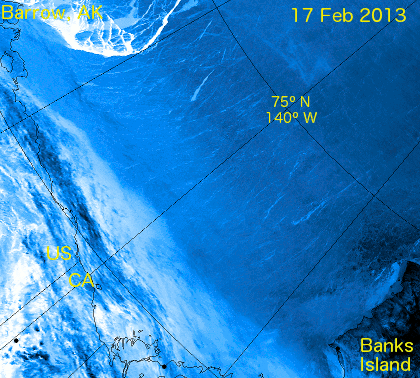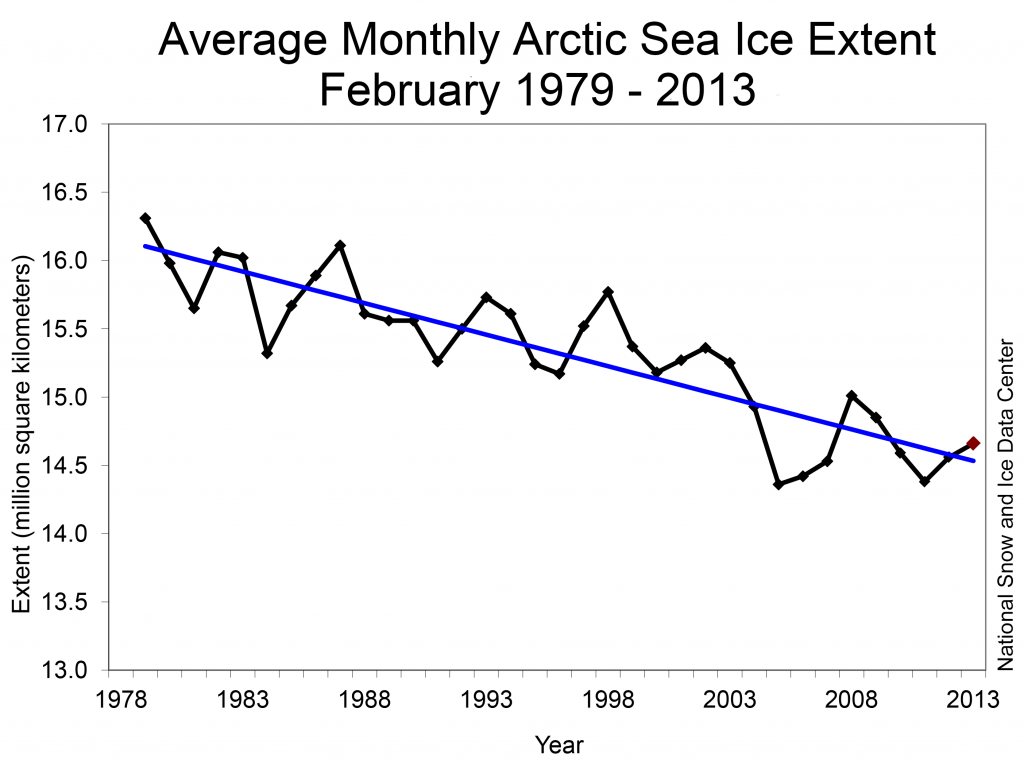13 March 2013
Arctic Storm Fractures Already Fragile Polar Ice
Posted by Dan Satterfield
The National Snow Ice Data Center has an update on the Arctic Ice for February out this week. Look at what an Arctic low pressure system did to the ice in the Beaufort Sea.
From the NSIDC:
During the last couple of weeks of February, a broad area of sea ice has fractured off the coast of Alaska and Canada, extending from Ellesmere Island in the Canadian Arctic to Barrow, Alaska. This fracturing event appears to be related to a storm that passed over the North Pole on February 8, 2013, creating strong off-shore ice motion. The large area of fractured ice is located in predominantly first-year ice, which is thinner and easier to fracture than thick, multiyear ice. Similar patterns were observed in early 2011 and 2008, but the 2013 fracturing is quite extensive. The animation (Figure 5) shows the progress of the fracturing, and the general strong rotation of the Beaufort Gyre ice motion pattern during late February. (See also this animation of the fracture from the AVHRR instrument, posted on the Arctic Sea Ice Blog.)
The trend in February Ice area is much the same as all of the other winter months- downward.
NSIDC:
Average sea ice extent for February 2013 was 14.66 million square kilometers (5.66 million square miles). This is 980,000 square kilometers (378,000 square miles) below the 1979 to 2000 average for the month, and is the seventh-lowest February extent in the satellite record. Since 2004, the February average extent has remained below 15 million square kilometers (5.79 million square miles) every year except 2008. Prior to 2004, February average extent had never been less than 15 million square kilometers. Ice extent remains slightly below average everywhere except the Bering Sea.
How is this loss affecting our day-to-day weather? Dr. Jennifer Francis at Rutgers University has been doing some fascinating research into just this question. You can see her entire talk from Jan 2012 below:




 Dan Satterfield has worked as an on air meteorologist for 32 years in Oklahoma, Florida and Alabama. Forecasting weather is Dan's job, but all of Earth Science is his passion. This journal is where Dan writes about things he has too little time for on air. Dan blogs about peer-reviewed Earth science for Junior High level audiences and up.
Dan Satterfield has worked as an on air meteorologist for 32 years in Oklahoma, Florida and Alabama. Forecasting weather is Dan's job, but all of Earth Science is his passion. This journal is where Dan writes about things he has too little time for on air. Dan blogs about peer-reviewed Earth science for Junior High level audiences and up.
was this just seen for the first time or does it happen every year?
Storms can break up ice and often do but the fact that the ice is much thinner now makes it much more susceptible. Much of the Arctic now has ice that is only one year old. The amount of older and thicker ice that lasts through several winters has diminished greatly.
Similar patterns in the past. They usually re-freeze quickly. Not this time. Also the scale is unprecedented and field survey concludes there is NO multi year ice in the Beaufort right now.